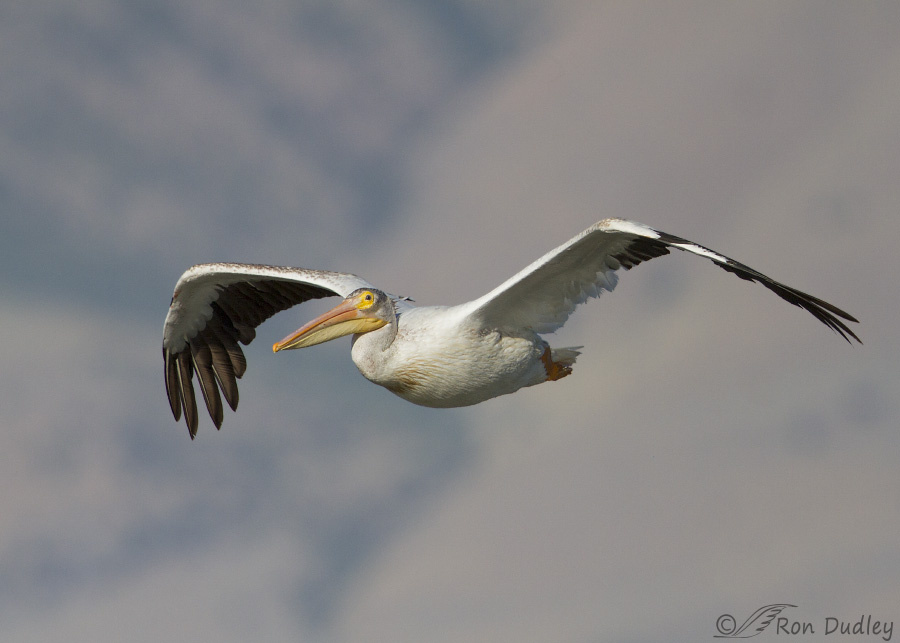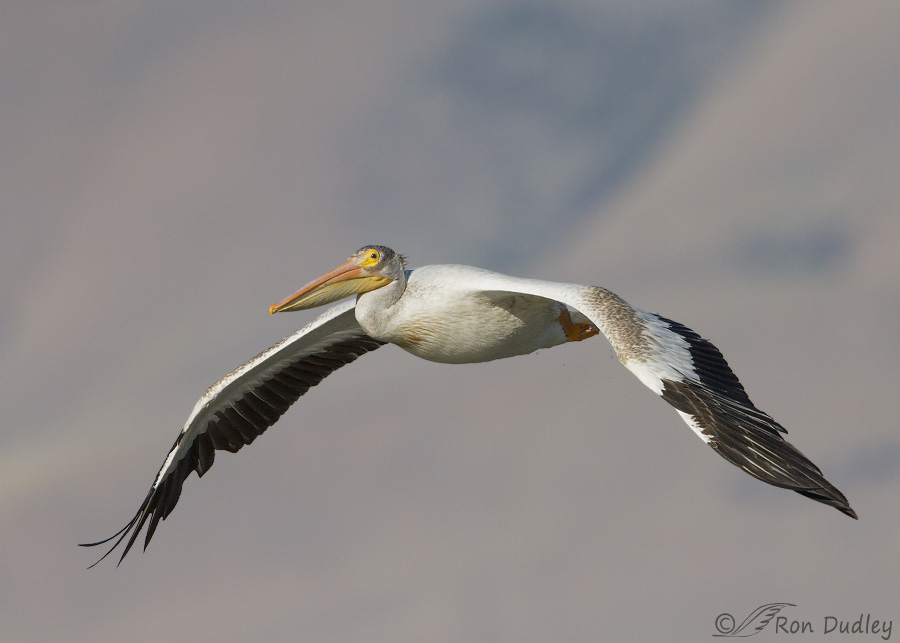I often think of American White Pelicans as flying boats. They’re huge and ungainly looking on land but in flight they’re ever so graceful.
1/5000, f/6.3, ISO 400, Canon 7D, Canon EF 500mm f/4L IS II USM + EF 1.4 III Extender, not baited, set up or called in
I photographed this one last August at Bear River Migratory Bird Refuge at the edge of a large impoundment where I was photographing other birds. When pelicans are in flight they typically don’t flap their wings much so I find it difficult to get dynamic wing positions. But this one came in close, the light angle is interesting and I really like the mottled background as opposed to homogenous blue or white sky.
1/5000, f/6.3, ISO 400, Canon 7D, Canon EF 500mm f/4L IS II USM + EF 1.4 III Extender, not baited, set up or called in
This is about as much wing flapping as I got. But the flight posture is slightly different and combined with the changes in the background this shot is different enough from the previous one that I decided to include them both.
The size of these birds in flight and up close is always impressive. They average about 16.5 lbs in weight but they’ve been reported as large as 29.92 lbs (that bird was reported by Dr. William H. Behle, my old Ornithology professor at the University of Utah). For the sake of comparison Great Blue Herons average about 6.4 lbs.
When this bird unexpectedly appeared I’d been photographing other birds on the darker water so I had no time to make any camera adjustments when I raised my lens for it – thus the incredibly fast shutter speed. I call shutter speeds in this range “hummingbird speeds”.
But I’ll guarantee you one thing – there isn’t any motion blur in this pelican’s wings!
Ron
Note to photographers – I was using my older Canon 7D because at the time my 7D Mark II wasn’t functioning correctly.




Ron,
I think I am learning that the key to sharpness is SS… and enough sun to keep the ISO below…??? What is your maximum?
Stephen
With the 7D Mark II I try very, very hard to never go above ISO 800.
Most beautiful, Ron! I look forward to your photo posts, even if I don’t always get to them the same day. I live in central Washington State, so we see White Pelicans in the spring and summer, and nesting at the Potholes. Love to see them flying high in formation.
Oh my! What beauty, crisp and, and well, your usual photographic wonderfulness!
White pelicans have a special place in my heart. They kept my sanity (battered, tattered and ragged as it is) while I recovered from double foot surgery. I’ll never forget the spectacularness of watching their simply incredible twisting, turning and flawless flying flock thing. How do they DO that? Just amazing!
They look almost prehistoric don’t they?
The clumsy/incredibly graceful equation always makes me think of penguins. Ungainly and awkward on the ground, and better than balletic in the water.
Perfect analogy to penguins, EC. And yes, they do look prehistoric – especially adults in the breeding season when they have that “horn” on their bill.
Yesterday I saw my first group at Forest Dale Lake. I love to see them soar in and land. It is also interesting to see them gang up on the carp in the lake. The fish are herded into a corner where they have no escape.Very military behavior.
Betty, Yes, they’re one of the few birds known for cooperative feeding. It’s really interesting behavior to watch.
These are super shots! Hummingbird shutter speed paid off — everything is so crisp. To me, the curve of the primaries reminds me of raptor wings.
I see mostly brown pelicans where I am. When I walk on the beach, I often see them dive bombing after fish. They come in perpendicular to the water’s surface. Spectacular!
I’d love to photograph that dive of the Brown Pelican, Marty. Thank you.
Come out and visit — I’ll show you around “my” coastal SoCal! 😀
It’s hard to believe that something as heavy as a frozen turkey can fly, much less be so graceful in the air…I especially like the first image…that’s a great background…the eyes ares are amazing….
“It’s hard to believe that something as heavy as a frozen turkey can fly”
And that would be a BIG frozen turkey, Patty – especially at the upper end of their weight range. Thank you.
I was looking at the eye, too, Patty. That detail reminds me of the old leather pilot helmets with goggles.
That pelican is beautiful! You don’t get a sense of their colors when they’re flying in formation overhead — so it’s a pleasure to see such a nice close-up of those tri-color wings and that bright yellow eye. They are my favorite non-raptor to watch in flight, see the brown ones frequently along the PCH in SoCal.
“They are my favorite non-raptor to watch in flight”
I’ve never thought of that in those terms, Chris, but now that I have I agree.
I like the way a group looks like a wheeling daytime constellation when high above in a bright blue sky.
Me too, Linda.
Love these guys and they are always fun to photograph. I am amazed at recorded weight of almost 30#. No wonder they have to work so hard to get off the water. I think I told you about the group feeding behavior we saw last summer after Montana Fish and Game finished releasing trout fingerlings in the Clark Canyon Reservoir. I think you described the behavior as “orchestrated”. Whatever kind of pelicans, they are one of my favorites. Thanks again for the post to go along with my 3rd cup of coffee.
I remember your story about Clark Canyon Res, Frank. I spend a lot of time in that area in late spring and early summer and see many pelicans there.
Our thoughts of these birds are similar! They’ve always reminded me of those old military cargo planes. I love to watch their little “squadrons” ride the air currents along the coast when I’m visiting in California.
That’s such a perfect analogy! 🙂
They sometimes make me think of B-52’s in the air.
Beautiful flight photos of the pelican. I agree, they remind me of flying boats too.
Thanks, Donna.
They don’t “flap” much – I love watching a flock glide through the air slow motion even if still camera shots don’t capture the beauty of it! 🙂 So different from their appearance on the water/ground. Great “sharp” detail for sure along with some wing motion! 🙂
Yes, they’re such a contrast – clumsy on the ground, the epitome of grace and beauty in the air.